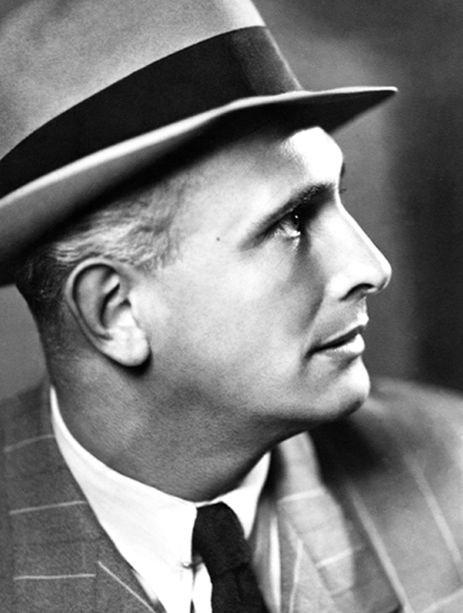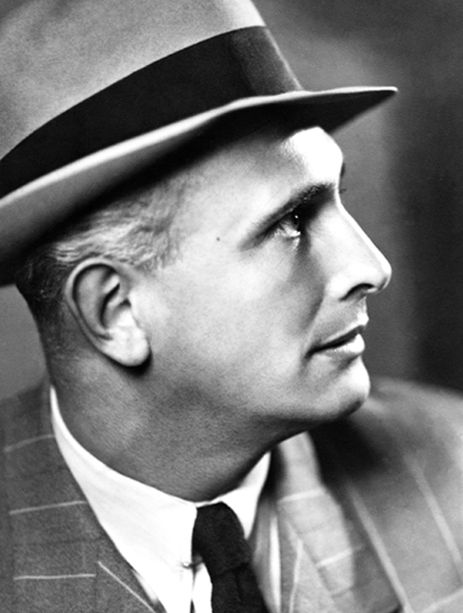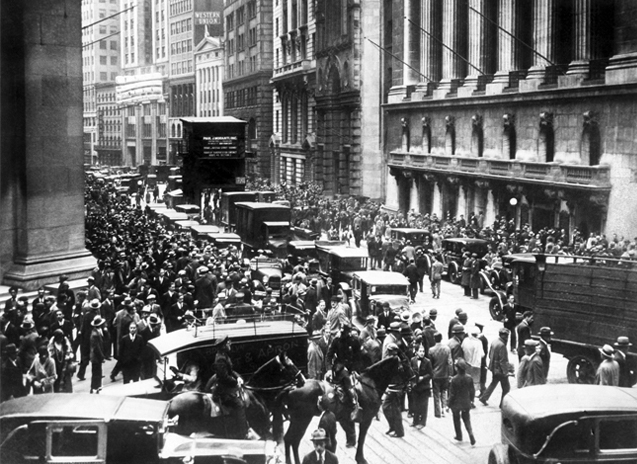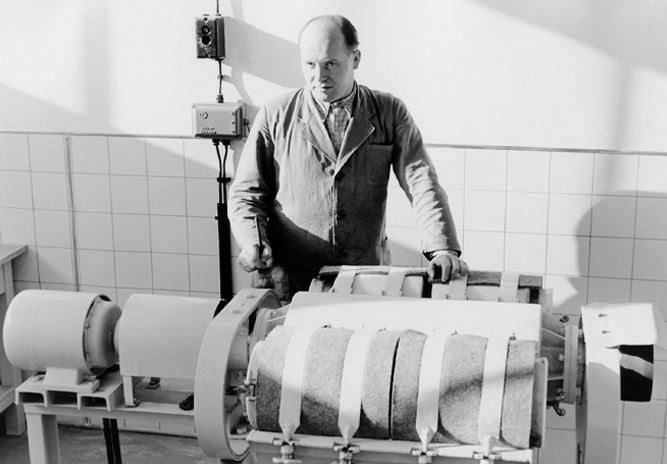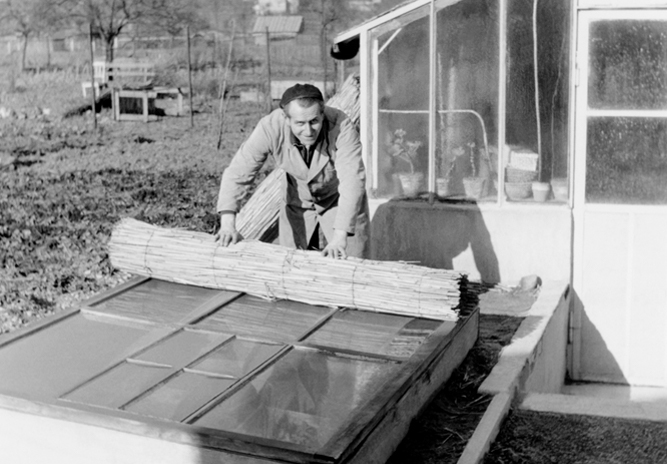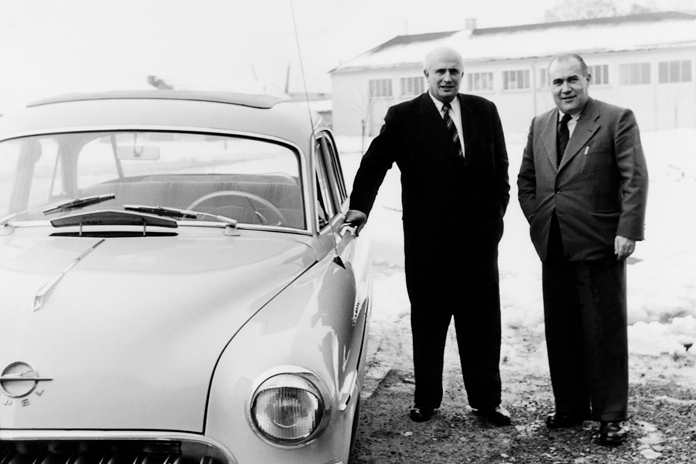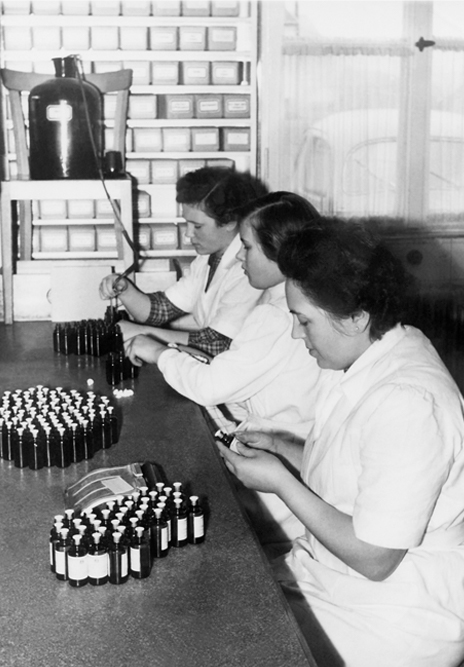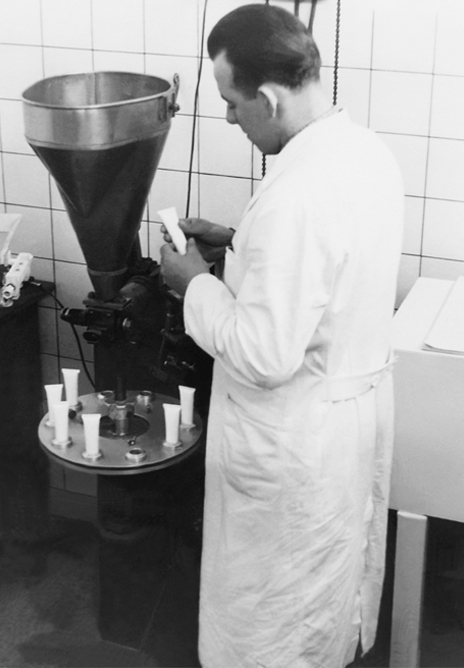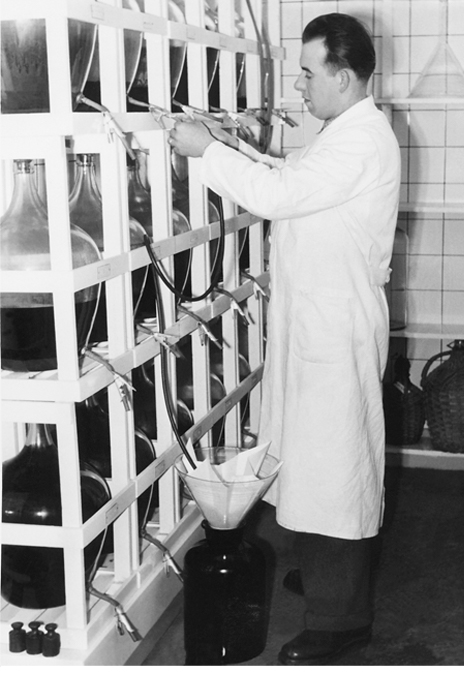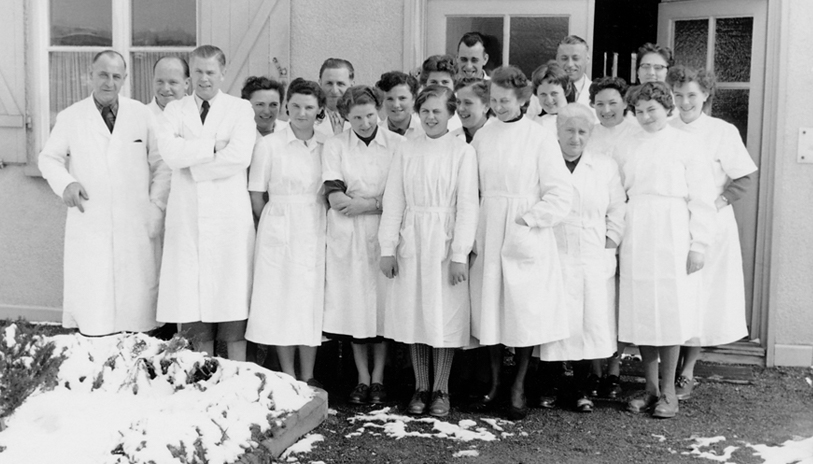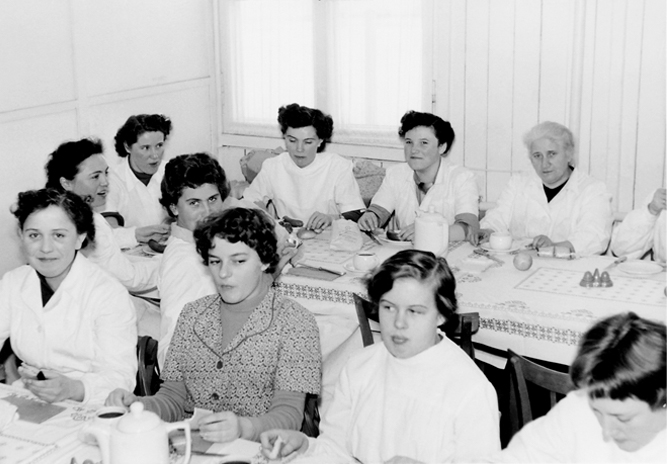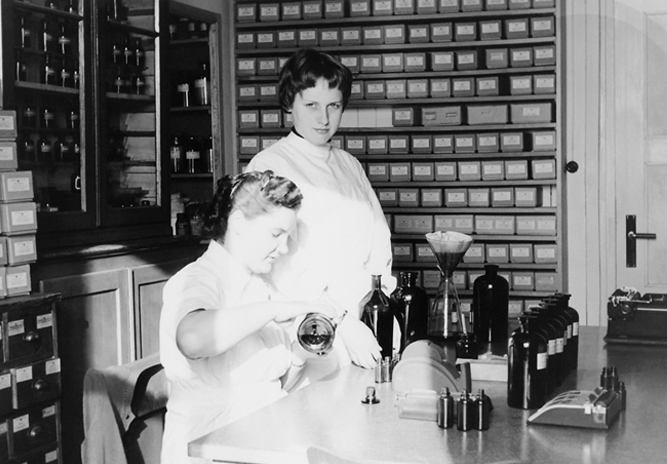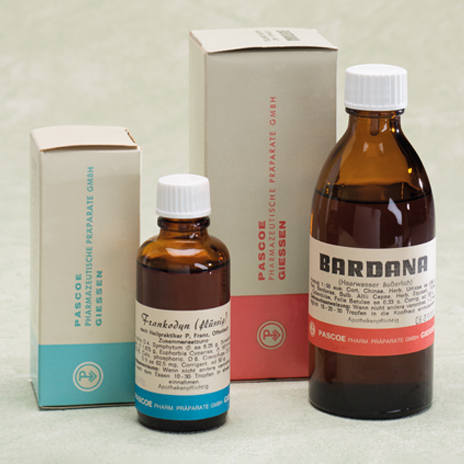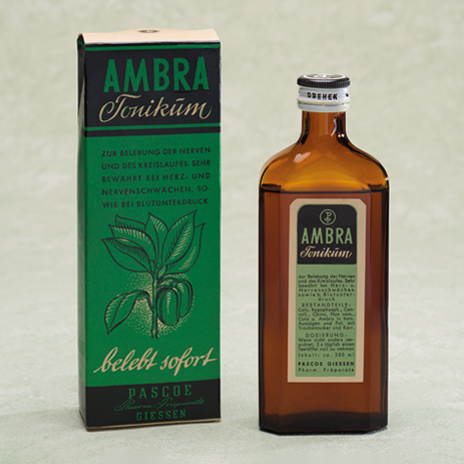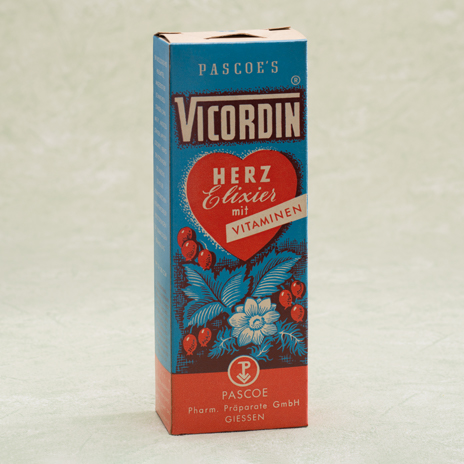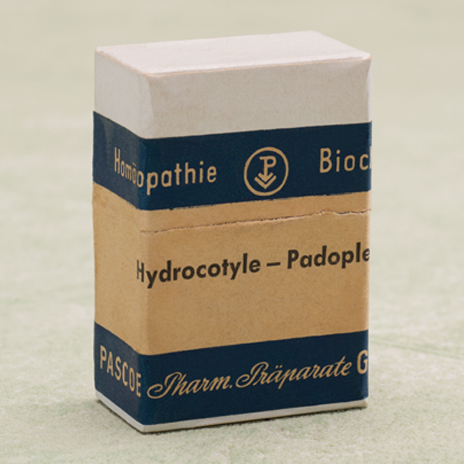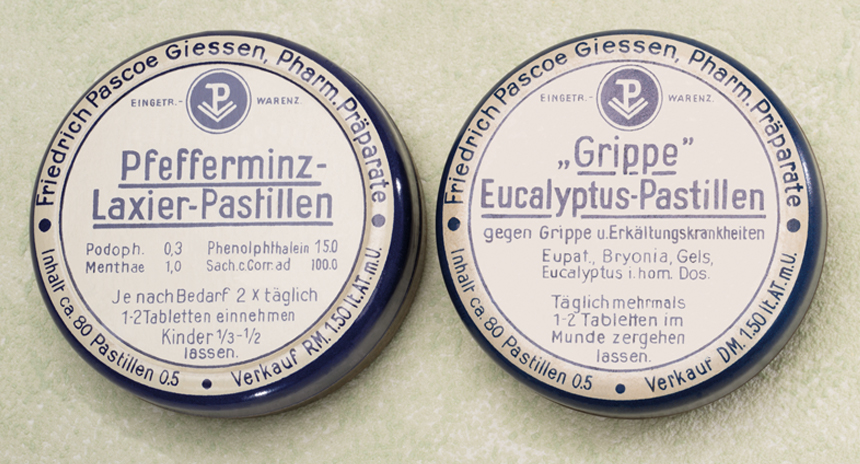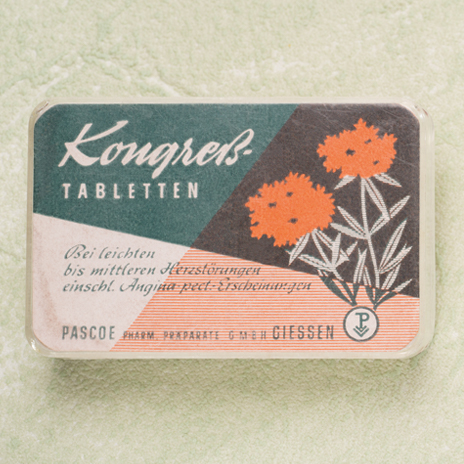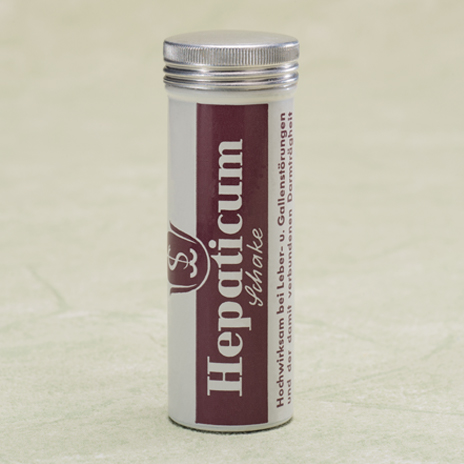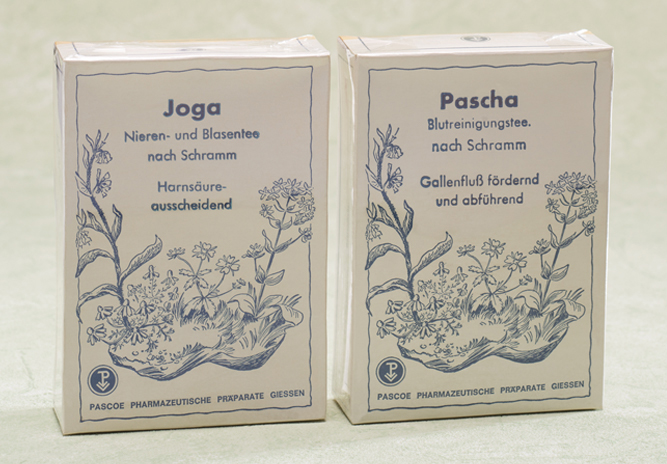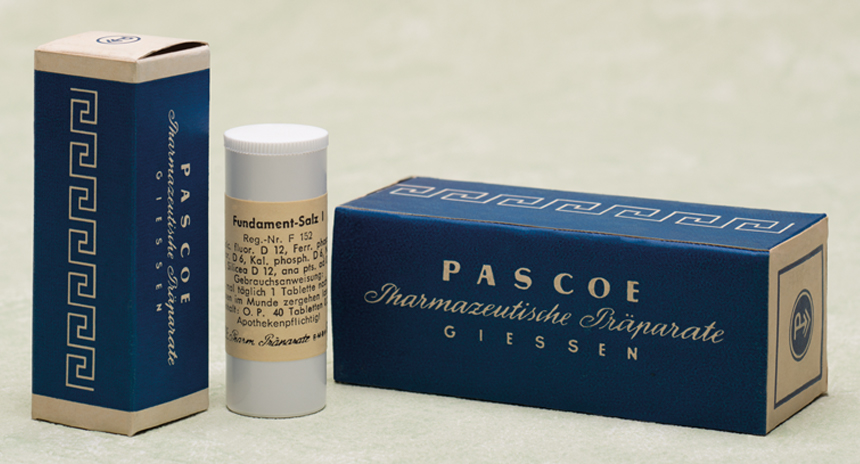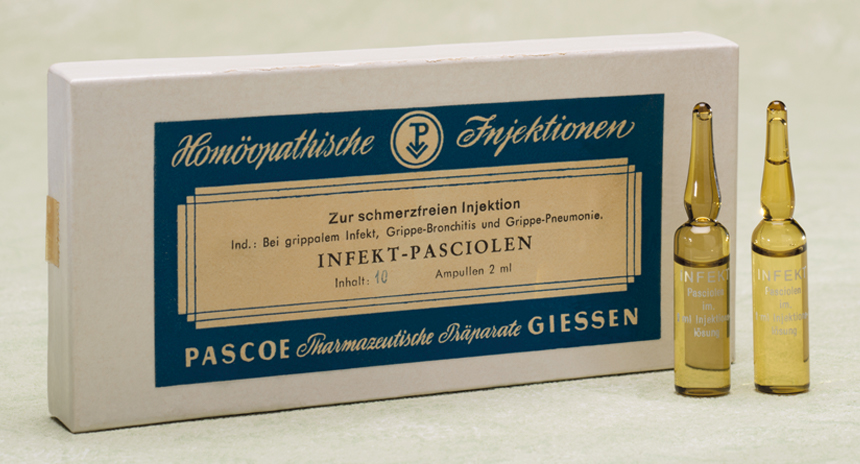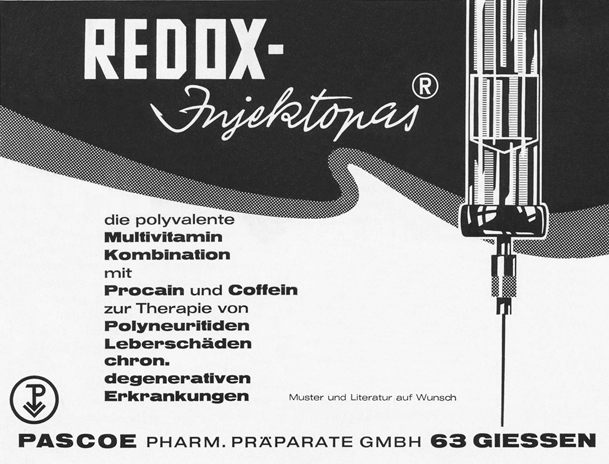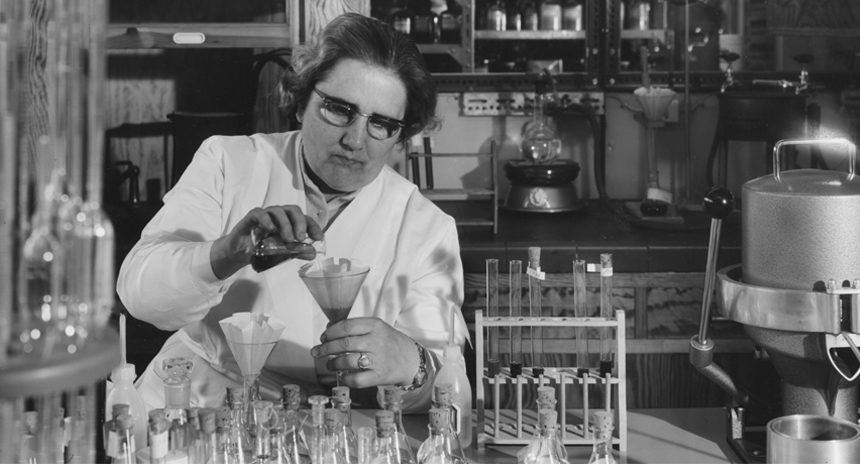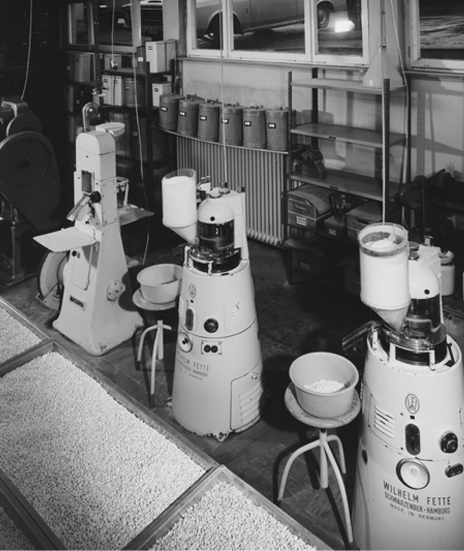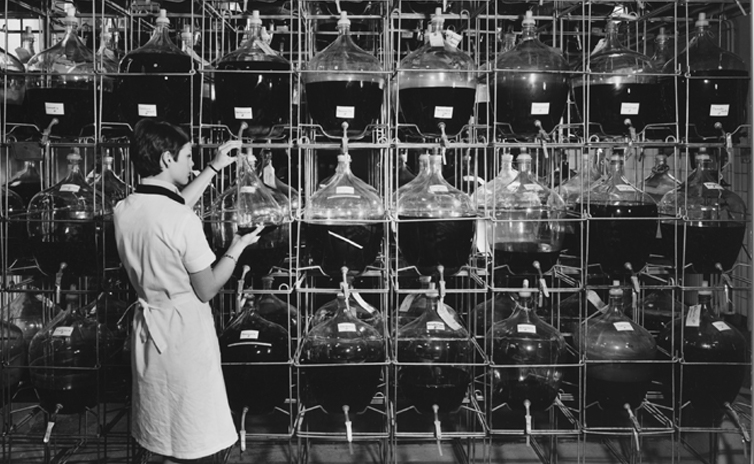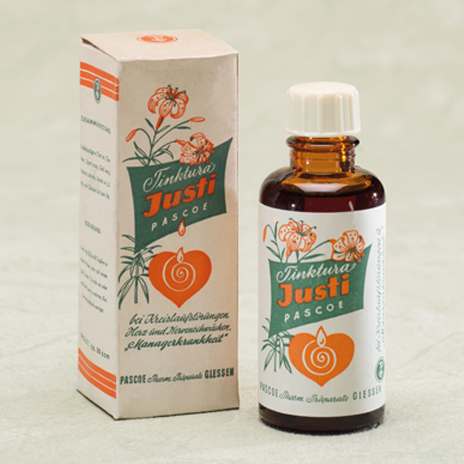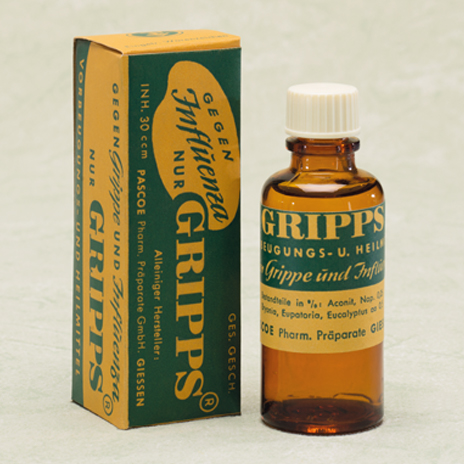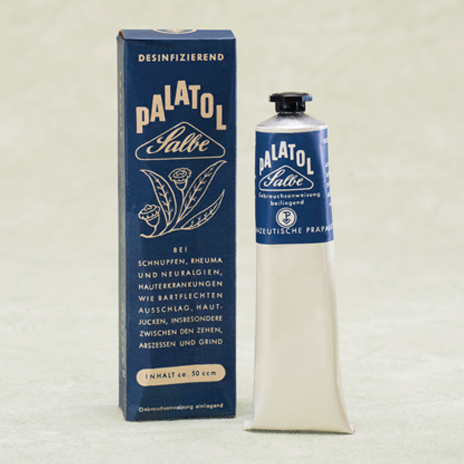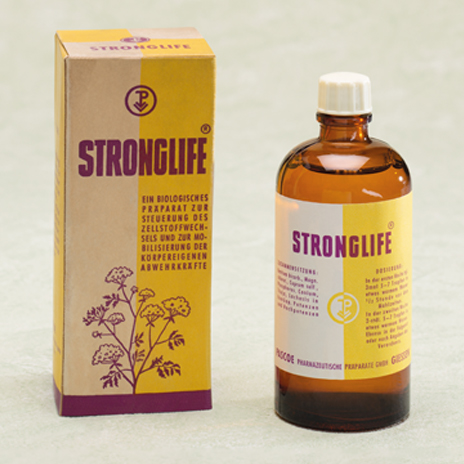Fritz Pascoe – an entrepreneur with a profile
Kapitel III: 1930-1970
20. Generational change in turbulent times
Friedrich Samuel Jacob Pascoe, called Fritz Pascoe, was facing a big challenge when he took over the company after the death of his father in May 1930. The son of Margareta and Friedrich Pascoe, born on 21st September 1899 in Mülheim an der Ruhr, had gone from school straight to the field during the First World War. After passing the preliminary pharmaceutical examination, he was enticed to foreign lands. From 1927, he worked as a paymaster on a relative’s plantation in the British colony that is present-day Cameroon. He wanted to gain a better understanding of cultivating healing plants there.
When Fritz Pascoe returned to Gießen in 1930 after three years in Africa, he found an established pharmaceutical business. He was presumably helped by experienced employees of his father, so transition to management was smooth. The young entrepreneur was still known and popular in Gießen for his performance in breaststroke swimming and as a water polo player. He was able to revive many contacts and soon after his return he resumed the chairmanship of the Gießen swimming club.
However, Fritz Pascoe had returned to his hometown in a generally difficult economic situation. What had started with the New York stock market crash on 24th October 1929 evolve into a global economic crisis, with dramatic consequences also in Germany. Major companies and banks collapsed, industrial production slumped and in 1930 there were already three million unemployed people. Growing poverty and social destabilisation fostered the political radicalisation of the population. A dense series of governmental crises further weakened the already fragile democratic system of the Weimar Republic. At the Reichstag elections on 14th September 1930, the National Socialist German Workers’ Party (NSDAP) was voted the second strongest party after the SPD. In Gießen it achieved 19.4 percent of the votes.
The National Socialists found followers in all population groups, including among naturopaths. The widely discussed crisis in medicine led to ideas of a synthesis of traditional medicine and alternative healing methods. Under the term New German Medical Science, a movement of doctors and medics was formed which was in part affiliated to the NSDAP. When the National Socialists came to power on 30th January 1933 with the appointment of Adolf Hitler as Reich Chancellor, many homeopaths, alternative healers and naturopaths expected a valorisation of their healing methods.
21. The homeopathic pharmacopoeia
The founder of homeopathy, Samuel Hahnemann, did not leave a homeopathic pharmacopoeia behind. It was the doctor Carl Caspari (1798-1828) who collected his details of the manufacturing of homeopathic remedies and published them in 1825 in the “Homeopathic Dispensatorium for Doctors and Pharmacists”. This initial work was followed by further editions. Between 1845 and 1878, the Centralverein Homöopathischer Ärzte (Central Association of Homeopathic Doctors) published a “Homeopathic Pharmacopoeia”. Later on, the association declared the “Pharmakopoea homeopathica polyglottica”, first published in 1872 by the manufacturer of homeopathic medicines Willmar Schwabe, as a general homeopathic reference volume.
His son with the same name published “Dr. Willmar Schwabe’s Homeopathic Pharmacopoea” in 1901. The second edition was officially recognised in 1934 by a Reich decree. In 1978, the first official homeopathic pharmcopoeia was published in the Federal Republic, in brief HAB 1. Up until today, Pascoe staff are involved as members of the pharmacopoeia commission in incorporating new findings into this work.
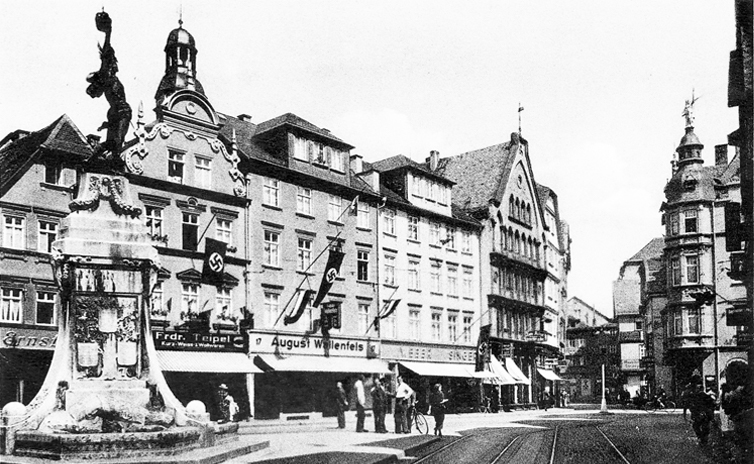
22. Between politics and ideology
The climate for natural medicine appeared to be favourable. Fritz Pascoe systematically expanded his father’s pharmaceutical business. He put together a balance product range with a focus on homeopathy and biochemistry, offering tinctures, liquids, globuli, triturations, tablets and special homeopathic ointments. The around 50 special homeopathic complexes that Friedrich Pascoe had passed on to his son and bore names such as Antis 1, Nervinum 3, Cordial 2, Pectoral 5 were supplemented by complex substances from other manufacturers. Pascoe also stocked supplements according to Schüssler such as salt pastilles and biochemical balms.
Business was going well. Alternative healing methods were very popular in the 1930s. Associations such as the Biochemical Association, the Prießnitz Association and followers of Hahnemann, Kneipp and Schuessler had hundreds of thousands of members. In the second half of the 1930s, according to estimations there were around 770 homeopathic doctors and around 3500 organised natural health practitioners in Germany. In 1935, the Reich Health Leader Dr. Gerhard Wagner founded the Reich Work Association for a New German Medical Science, in which homeopathy was represented alongside other natural health practices. For a while, it looked as though the National Socialists wanted to promote natural medicine.
The manufacturers of pharmaceutical products also benefitted from this development. Fritz Pascoe sold medicines against the flu, rheumatism, gastrointestinal complaints, cardiac complaints and sleep disorders under his introduced trademarks. Medical wines, massage oils and teas were also part of the product range. “Reform products according to Burtschell” were also added. In March 1939, Fritz Pascoe had concluded a contract with the nutritional expert Barbara Burtschell from Mainz, in accordance with which he took over 26 of her products as part of his product range: nutritional salts, pastilles, skin oils, ear balm and cough mixture, juniper honey, liver and gall bladder drops, as well as strengthening substances for the heart, nerves and stomach.
23. Natural medicine in the Second World War
In 1939, just before the start of the Second World War, natural medicine enjoyed wider recognition. After an amendment to the medical code, established doctors could offer natural medicine and some universities and clinics started to be involved more intensively in “biological processes”. The “law for the professional practice of natural medicine without a licence” of 17th February 1939 formed the legal basis for the occupational title of natural health practitioner. On the other hand, this law made professional practice dependent on state authorisation, which led to a reduction in up-and-coming practitioners, as only few received the necessary practice permit.
In the state healthcare system, traditional medicine was still clearly predominant. The Reich Health Leader Wagner campaigned increasingly often against purported “extremists” and “dogmatists” in natural medicine. He demanded compliance with health policy measures, such as the strict observation of vaccination laws. Since the beginning of the war, the regime had been making the utmost effort to ensure emergency medical care, so there was scarcely room for alternative methods. The healthcare system was instrumentalised in order to maintain power and was subject to strict regulations. This also affected Fritz Pascoe, when he was asked in Mach 1943 by the Reich Pharmacy Chamber to change his company name. He was forced to waive the addition of pharmacist, as he himself was not a pharmacist. Thereafter, his company was known as Friedrich Pascoe Pharmaceutical Products. Manufacturing and sales of the products continued during the war but with restrictions. There was ongoing demand for the introduced medicines but increasingly frequently there was a lack of raw materials. Fritz Pascoe himself was enlisted and served his military service as a medic.
For the few remaining employees, the effects of the Second World War were increasingly felt, especially in everyday life. In December 1944, Gießen was the target of bomb attacks several times. The Pascoe company building at the time was also completely destroyed and subsequently regular production ended. When US troops arrived in Gießen on 27th March 1945, the town centre was 90 percent destroyed. Administration, supplies and transport scarcely functioned anymore.
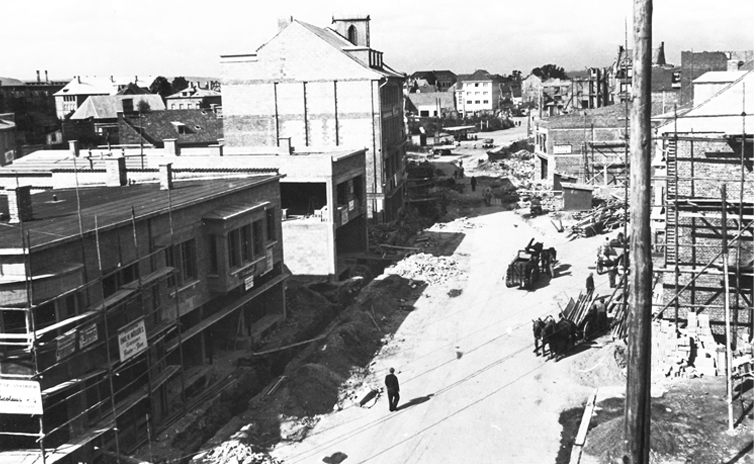
24. Post-war years
After returning to Gießen, Fritz Pascoe resumed pharmaceutical business again with a small circle of loyal employees in makeshift rooms. In the immediate post-war period, improvisations were necessary everywhere. It was only in the years 1948/49 that normality was gradually restored: the currency reform in June 1948 with the introduction of the Deutschmark forged stable economic conditions and Pascoe found suitable premises for its business at Bleichstraße 7.
The market for their products was developing well, because alternative remedies, especially homeopathy and phytotherapy, were enjoying great popularity. Since the late 1940s, specialist magazines were once again being published, such as Naturarzt and Hippokrates, and natural medicine and medical associations were being newly founded. The pharmaceutical industry was organised in 1951 in the Federal Association (BPI), which Fritz Pascoe joined as a founding member.
At Bleichstraße at the beginning of the 1950s, Fritz Pascoe produced phytotherapeutic specialities and complex homeopathic remedies with around 15 employees. The facilities in the cellar of the building were simple: there were two trituration machines to manufacture powder products and a tube filling machine for balms. Pascoe had taken them over from the Gießen mustard factory Quambusch and set them up for their own purposes. Tablets were produced with two presses, which were packed into little tubes with the help of a wooden funnel. Liquid remedies were filled by hand by employees into prepared little vials, which were then corked. A pharmacist set the tinctures, a chemist carried out the quality controls. Fritz Pascoe and his procurator processed the orders in the office.
The entrepreneur and his staff were a sworn community. While Fritz Pascoe led employees in production himself, colleagues supported each other mutually in their tasks, because there were scarcely any clearly defined remits. In the evening, an employee took the daily production to the post office with a handcart. Everyone knew how tight the financial situation was. It was only if deliveries were timely and customers paid their invoices on time that Pascoe could pay the weekly wages on Fridays. But business was gaining momentum and the Bleichstraße premises were getting too small. Fritz Pascoe ventured the first step towards expansion.
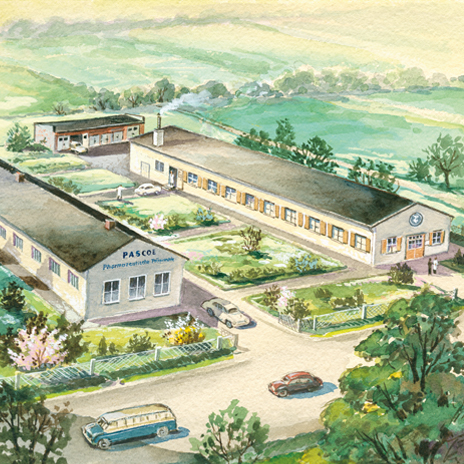
25. New location Schiffenberger Weg
On Schiffenberger Weg, in a newly developing industrial area on the edge of Gießen, Fritz Pascoe found a location for his growing company. His wife Inge, who after the marriage had moved to Hessen with her two daughters Marion and Birgit from her first marriage, supported him, even though the purchase of the site had to be financed by means of a bank credit.
When Pascoe relocated in 1952, on the site there were only a former military barracks and the factory hall of a metalworks company. Financial reserves were lacking, so employees collected old paper to buy roof planks that were used to make shelves.
Fritz Pascoe drummed up the money for motorisation, because he was partial to vehicles: he acquired the three-wheeler small transporter Goliath for the company, which was used to transport goods to the train station. Privately he used a Borgward. Fritz Pascoe was thereby among the first car owners in Gießen after the Second World War.
The start of business in Schiffenberger Tal was modest but growth was considerable. In the mid-1950s, there were already around 30 employees working within a space of 600 square metres. They were now operating six trituration and three tableting machines. Two dry cabinets, balm mills and tincture presses, as well as a tube filling and closing machine were also available. A bottle washing facility, complete ampoule equipment with a distiller and sterilizer, as well as two ball mills facilitated work. In the middle of the company site, Pascoe had a healing plant garden laid out. In 1956 he also started building a residential house for his family, just in time before the “building child” Jürgen, the married couple’s only son, was born.
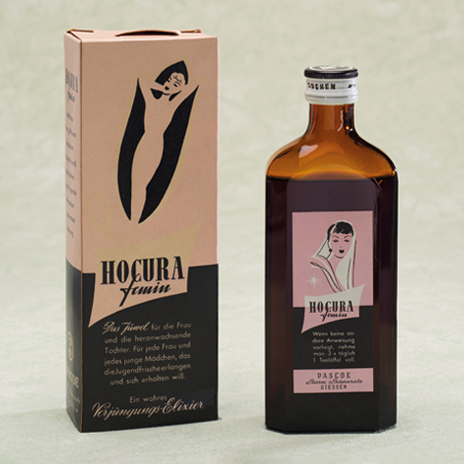
When the economic miracle gained momentum in western Germany at the end of the 1950s, expenditure for medicines increased, both in traditional medicine and in alternative medicine. Homeopathy, phytotherapy and other approaches experienced a huge book under the notion of holistic medicine. Bitterly fought battles between different movements lost importance and made way for variety in medicine. From 1956, doctors were able to bear the additional title of homeopath, in 1957 the licence to practice, the later medical licensure act, was extended by an examination in the subject of botanics, which took account of the most important healing plants. Pascoe continuously increased the turnover for his pharmaceutical products. They were prescribed by natural medicine practitioners and valued by patients. The product range included injections, Pascoe complex and specialities, as well as those under the trademark Hocura.
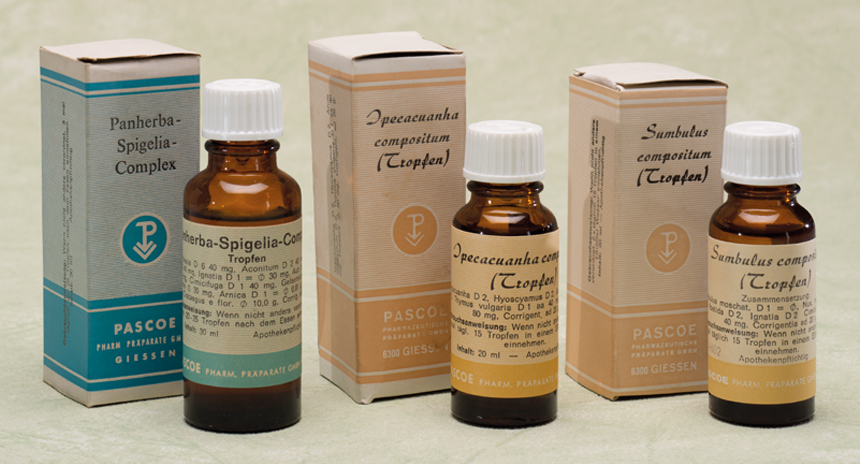
The effect of homeopathic remedies had to be proven in order to raise acceptance among doctors, health practitioners and pharmacists, ideally through clinical studies. Apart from this requisite, which affected all manufacturers, Pascoe was faced with another particular problem. The product range comprised more than 6000 remedies, including 200 complex remedies, a huge variety that presented increasing difficulties in production and sales. Fritz Pascoe looked for ways to structure his inventory. The first step in 1961 was the founding of a scientific division that provided a secure basis for the development and testing of products.
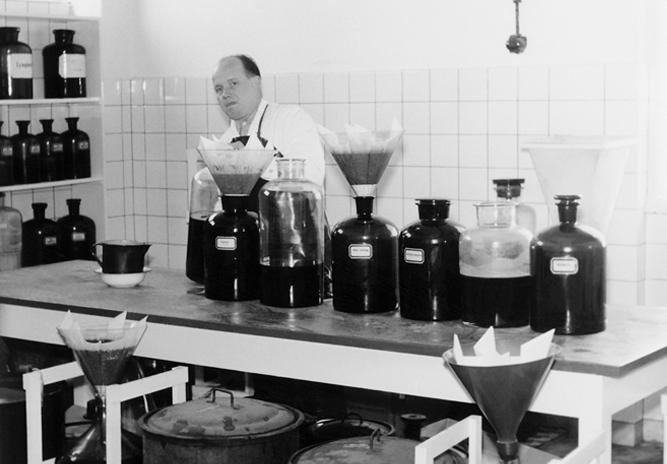
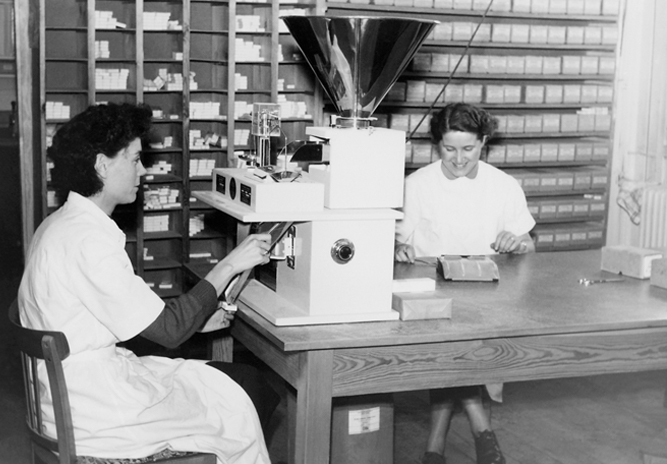
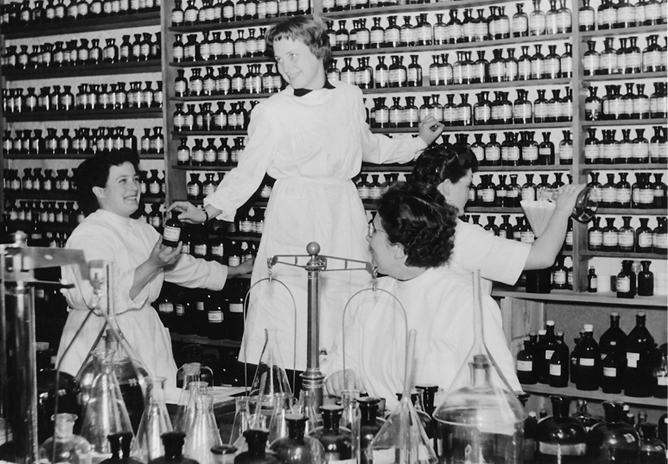
27. Two medics, one journal and a lot of fresh impetus
At a natural medicine congress in Wetzlar, Fritz Pascoe made acquaintance with Dr. Horst F. Herget (1921-2001), who is considered a pioneer of pain therapy in Germany, and Dr. Helmut W. Schimmel (1928-2003). This encounter gave the pharmaceutical manufacturer and especially the scientific division decisive new impulses. The study friends each ran a dental practice and also worked as natural health practitioners. Both of them had completed human medicine studies after dentistry studies and in their work were orientated towards constitution medicine and iridodiagnosis, healing practices that were compatible with the pharmaceutical orientation of Fritz Pascoe. The men soon agreed a cooperation Herget and Schimmel started to select around 100 complex remedies from Pascoe’s product range and to put them together as a system by the name of Similiaplex. The foundation stone for the family of complex remedies that continues until today was laid.
Herget and Schimmel also acted as speakers. For many years, they presented the Pascoe products, as well as constitution medicine and iridodiagnosis, at medical and alternative practitioner congresses. Fritz Pascoe often presented his products at a stand. At the end of the 1960s, up to 100 interested persons took part in Pascoe’s Similiaplex congresses in the spring and autumn at the Gießen congress hall. In addition, Herget and Schimmel held presentations in many German cities, to which Pascoe invited the local doctors and alternative health practitioners. These also enjoyed a very positive reception. While Pascoe satisfied the need for information with these events, he also extended field sales and thus stimulated a turnover increase. The representatives had to be very convincing, because many doctors and health practitioners did not know Pascoe and the Pascoe products. It took a lot of effort and patience to change this.
The scientific division of Herget and Schimmel played an ever greater role in further development. The two medics initiated numerous long-term clinical studies together with health practitioners and doctors, in order to prove the effectiveness of products. Pascoe published the results from 1962 in the in-house journal Acta Biologica, a medical and scientific “journal for applied homeo-phytotherapy, holistic treatments and special methods in medicine”. The publication was aimed at doctors and health practitioners and the authors also came from their ranks. Herget and Schimmel were especially active contributors. The “Acta” and its topics were wide-ranging. It was about the treatment of chronic diseases, pain therapy, children’s medicine or manual therapies. The journal also provided information on medical topics from nutrition to chakras to traditional Chinese medicine. Constitution medicine, on which the healing concept of Herget and Schimmel was based, repeatedly played a central role.
Constitution therapy and the increased interaction with the specialist public and scientific research gave Pascoe a new profile. The company gained renown among doctors and health practitioners, which was also reflected in economic success. “Almost hectic activity” took place in the dispatch department in the 1960s. Alongside doctors and health practitioners, Pascoe was now supplying almost all wholesalers and pharmacies in western Germany. Four times a day, deliveries left the warehouse to ensure they reached customers as quickly as possible.
28. Constitution medicine and iridodiagnosis
The constitution of a person, i.e. their condition and physical state, had always been of great importance in natural medicine but in modern medicine in the 20th century it was increasingly in the background. Pascoe’s medics Herget and Schimel understood constitution to be the individual wholeness of the individual person. Many factors influence the sum of all innate properties, from environmental burdens to psychosocial stress. The weakest organ reacts with illness to stimuli that are too strong; this weak spot, disposition, is considered as the hereditary or acquired readiness of the organism to respond to harmful stimuli with illness. Treatments with phytopharmaceuticals and homeopathy were mostly based on traditional humoral medicine or humour theory, which had been modernised by Bernhard Aschner (1883-1960) in the 20th century.
Schimmel extended the definition of constitution and the resulting therapy by one criterion: the constitution and disposition determined by the eye. As a diagnostic method, iridodiagnosis, which draws conclusions about the constitution of a person from the pigmentation of the eye, had already been known for a long time. It was first applied in the 19th century by the Hungarian doctor Ignaz von Péczely. The “mud doctor” Emanuel Felke also trusted in this method. The natural health practitioner Josef Deck (1924-1990) was among the most influential iridologists, who initiated the Ettlinger International Courses for Iridodiagnosis in 1952. On this basis, Schimmel and Herget developed prescriptions for Pascoe based on the eye. With the help of a constitution scheme, the practitioner selected the suitable complex homeopathic and phytotherapeutic remedies.
29. Solutions, vitamins and more
Through the close contact with medics in practices and clinics, Pascoe entered new fields of business. Cooking salt and other solutions used in hospitals were manufactured in their own ampoule and infusion department. The company had invested in this: high-performance machines filled the ampoules and infusion bottles, while sterilisation took place in autoclaves. Up to 1000 litres of infusion solutions could be produce daily according to strict hygiene regulations. In addition, there were the Injektopas injection products, in which Pascoe invested great hope, because substances in an injection opened up new treatment possibilities. This also applied in particular to various vitamins, which were also offered as injections in a high dose.
Nutrition had already played a central role in natural medicine since the 19th century but gained new significance in the wealthy society of the economic miracle years. As nutritional habits changed and for example the consumption of dark bread declined, deficiencies and diseases of civilization emerged. Vital substances were supposed to balance the deficits. Pascoe advocated multivitamin therapy in particular: the Pascoe multivitamin dragées, for example, included nine different vitamins that promised help especially for fatigue. However, the remedy was intended to only be a “stopgap” and to only be taken “until a balanced diet has once again given the healthy organism the possibility to extract from food everything it needs for its maintenance”. With this approach and the associated products, Pascoe laid important foundations. Especially high-dose vitamin remedies in tablets or injections are an important component of the product range to this day, with which Pascoe stands out from the competition.
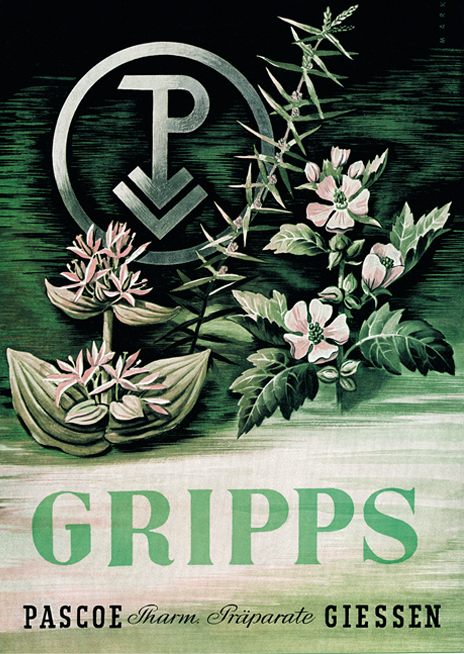
30. Modern factory for pharmaceutical products
The success of the product range of homeopathic and phytotherapeutic products was testified to by the growth of the company. In 1969, Fritz Pascoe produced with around 100 employees on premises of more than 5000 square metres. A small enterprise characterised by manual work had become a company with industrial manufacturing.
Production, business administration, the pharmaceutical control laboratory, the medical-scientific division and the warehousing and packing rooms were housed in three buildings. The tinctures, alcohol and solid substances were safely stored in canisters and tanks in the cellar, where there was also a hydraulic special press for fresh plant juices and tincture bases. The whole production process from the manufacturing of the tinctures made of fresh and dried plants to the manufacturing of the remedies, packing and dispatch took place at the Schiffenberger Weg location. Fritz Pascoe had continuously improved the facilities: powder in a homeopathic potentisation was manufactured by trituration mills with a high degree of refinement. Tableting machines manufactured up to 36,000 tablets per hour. In large rotating copper basins, the kernels were coated several times with a pleasant-tasting coating mass and then smoothed and polished. Instead of a sugared solution, Pascoe was now using a coating suitable for diabetics. Liquid remedies such as Similiaplex was filled in a fully automated system that could churn out 3600 vials per hour. Balm liquifying basins, homogenising devices for emulsions and special machines for the pouring and wrapping of suppositories in aluminium foil rounded off the machine park.
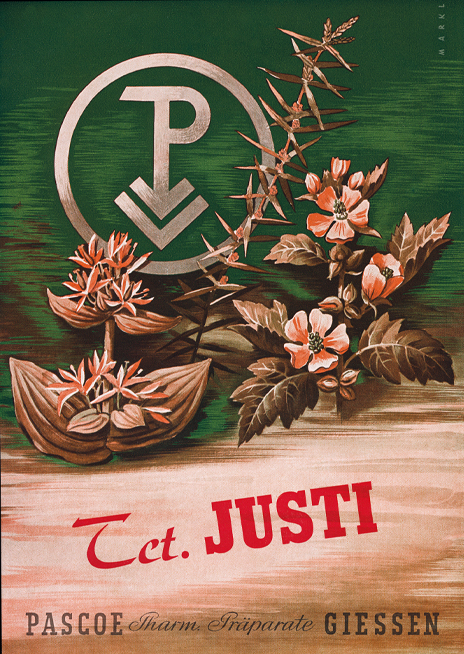
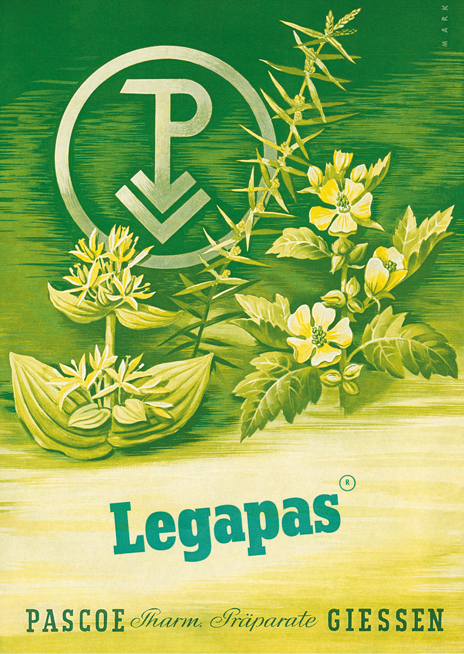
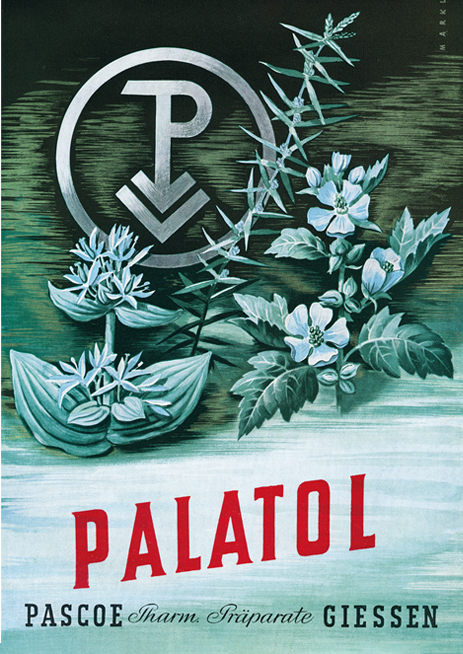
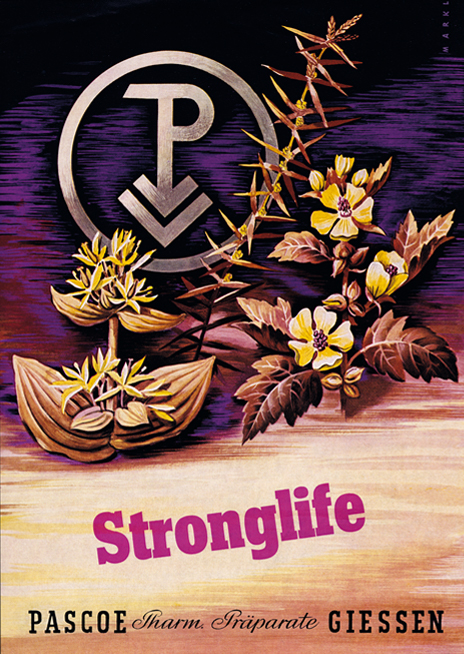
31. In a fixed location
For all the modernisations in production, the control laboratory and the scientific division remained the centrepieces of the company. While the laboratory ensured the quality of the raw materials and remedies, under the direction of an experienced chemist, the scientists enabled the development of new remedies. They maintained contact with universities and scientific institutes, in order to remain at the cutting edge of medicine and pharmacology. They also exchanged information with practitioners to find out how the Pascoe remedies were working and where improvements were needed.
Although traditional medicine had achieved great success after the Second World War in combatting acute, life-threatening diseases, it was often at a loss when it came to chronic diseases or so-called civilisational damage. For these, many patients trusted in a holistic approach and more in plant-based remedies than in chemicals. Unease towards medicines was growing in light of many unwanted side effects, which gave natural medicine with its natural remedies and substances a further boost. Pascoe had cemented a firm position in the field of homeopathic, biological and phytotherapeutic remedies.
Within 40 years, Fritz Pascoe had developed the company into a medium-sized company in the pharmaceutical sector. As the MD, he remained a leading figure throughout all the innovations and expansions. Blessed himself with great vitality, regularly swimming in the Lahn even at an advanced age, he led Pascoe with charisma. He allowed leeway for new ideas and won his employees over with his generosity. It hit Pascoe all the harder when the entrepreneur died on 18th June 1970. Inge Pascoe, who had always supported her husband, was now facing a similarly big challenge to Fritz Pascoe 40 years previously. The company was well positioned but needed clear direction in order to maintain its standing.

